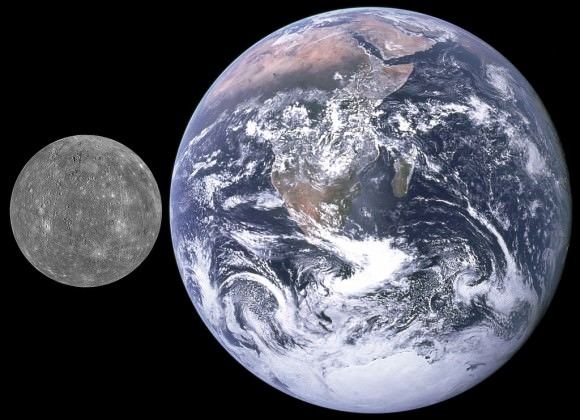The Solar Planets are a nice mixed bag of what is possible when it comes to planetary formation. Within the inner Solar System, you have the terrestrial planets – bodies that are composed primarily of silicate minerals and metals. And in the outer Solar System, you have the gas giants and bodies that are composed primarily of ice that lie just beyond in the Trans-Neptunian region.
Of these, the question of which planet is the smallest has been the subject of some controversy. Until recently, the smallest planet was considered to be Pluto. But with the 2006 IAU Resolution that put constraints on what the definition of a planet entails, that status has since passed to Mercury. So in addition to being the closest planet to the Sun, Mercury is also the smallest.
Size and Mass:
With a mean radius of 2440 km, Mercury is the smallest planet in our Solar System, equivalent in size to 0.38 Earths. And given that it has its experiences no flattening at the poles – like Venus, which means it is an almost perfectly spherical body – its radius is the same at the poles as it is the equator.
And while it is smaller than the largest natural satellites in our Solar System – such as Ganymede and Titan – it is more massive. At 3.3011×1023 kg in mass (33 trillion trillion metric tons; 36.3 trillion trillion US tons), it is equivalent to 0.055 Earths in terms of mass.

Density, Volume:
On top of that, Mercury is significantly more dense than bodies its size. In fact, Mercury’s density (at 5.427 g/cm3) is the second highest in the Solar System, only slightly less than Earth’s (5.515 g/cm3). The result of this is a gravitational force of 3.7 m/s2, which is 0.38 times that of Earth (0.38 g). In essence, this means that if you could stand on the surface of Mercury, you would weight 38% as much as you do on Earth.
In terms of volume, Mercury once again becomes a bit diminutive, at least by Earth standards. Basically, Mercury has a volume of 6.083×1010 km³ (60 billion cubic km; 14.39 trillion cubic miles) which works out to 0.056 times the volume of the Earth. In other words, you could fit Mercury inside Earth almost twenty times over.
Structure and Composition:
Like Earth, Venus and Mars, Mercury is a terrestrial planet, meaning that is primarily composed of silicate minerals and metals that are differentiated between a metallic core and a silicate mantle and crust. But in Mercury’s case, the core is oversized compared to the other terrestrial planets, measuring some 1,800 km (approx. 1,118.5 mi) in radius, and therefore occupying 42% of the planet’s volume (compared to Earth’s 17%).

Another interesting feature about Mercury’s core is the fact that it has a higher iron content than that of any other major planet in the Solar System. Several theories have been proposed to explain this, the most widely-accepted being that Mercury was once a larger planet that was struck by a planetesimal that stripped away much of the original crust and mantle, leaving behind the core as a major component.
Beyond the core is a mantle that measures 500 – 700 km (310 – 435 mi) in thickness and is composed primarily of silicate material. The outermost layer is Mercury’s crust, which is composed of silicate material that is believed to be 100 – 300 km thick.
Yes, Mercury is a pretty small customer when compared to its brothers, sisters and distant cousins in the Solar System. However, it is also one of the densest, hottest and most irradiated. So while small, no one would ever accuse this planet of not being really tough!
We have written many interesting articles on Mercury and the Solar Planets here at Universe Today. Here’s What is the Biggest Planet in the Solar System?, What is the Second Largest Planet in the Solar System?, How Does Mercury Compare to Earth?, What is the Average Surface Temperature on Mercury?, How Long is a Day on Mercury?, and The Orbit of Mercury, How Long is a Year on Mercury?,
And here’s another take on the smallest planet in the Solar System, and here’s a link to NASA’s Solar System Exploration Guide.
We have recorded a whole series of podcasts about the Solar System at Astronomy Cast.
Sources:


The IAU resolution represents just one view in an ongoing debate. For the many planetary scientists who adhere to a geophysical definition instead, dwarf planets are planets too, making Ceres the solar system’s smallest planet.
Are you sure that volume is correct? 60 trillion km3 seems a bit much…. 60 billion perhaps?